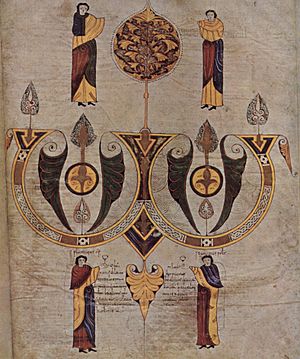León Bible of 960 facts for kids
The León Bible of 960 is a very old and special book. It's a Bible manuscript, which means it was copied by hand. It was also beautifully decorated with pictures, a process called illumination. This amazing book was finished in the year 960 at a monastery called Valeránica, located in Tordómar, Spain.
Today, you can find this Bible in the library of the Basílica de San Isidoro, León. We don't know exactly how it got there. The monastery where it was made disappeared around the end of the 900s. So, it's possible that King Ferdinand I of Leon and his wife Sancha, who were big supporters of the Basilica, gave it to them in the 1000s.
Contents
Who Made This Bible?
The end of the Bible, called the colophon, tells us it was finished on June 19, 960. It was copied and decorated by a person named Sanctus and his teacher, Florentius. It's hard to tell their work apart, but they are shown together in one of the Bible's pictures. They are celebrating its completion under a large omega symbol. Some people think this picture might have been inspired by Islamic art showing heavenly feasts.
What Does the Bible Look Like?
The text in the León Bible is written in two columns. It uses a special old Spanish handwriting style called Visigothic minuscule. This style was common in Spanish books between the 700s and 1100s. The Bible also has many notes, called glosses, written in Latin and Arabic. These notes help explain parts of the text.
Amazing Illustrations and Art
The Bible starts with a large, full-page picture. It shows Christ with symbols of the four evangelists (Matthew, Mark, Luke, and John) in round shapes. After this, there are ten pages of family trees, showing how Christ is related to Adam and Eve.
The Old Testament part of the Bible is very decorated. It has about 80 pictures placed right within the text columns. These pictures illustrate the stories written just above them. The New Testament has fewer pictures, but it includes ten pages of special tables called canon tables. There are also small pictures of saint Paul at the beginning of his letters. The style of these pictures is similar to other famous Spanish illuminated manuscripts from that time, like the Beatus manuscripts.
Gallery
-
The first letter of the Book of Genesis
Where Did the Art Ideas Come From?
The pictures and decorations in the León Bible of 960 got their ideas from different places.
Older Bible Influences
The way the Old Testament pictures are arranged suggests they were copied from an older Visigothic Bible that is now lost. That lost Bible might have been copied from even older decorated books. Florentius, one of the artists of the 960 Bible, made another Bible in the same monastery in 943 (which is also lost). This earlier Bible might have been a model for the 960 Bible. Florentius also worked on another book called the Commentary on Job of 945, which could have inspired some of the art in the 960 Bible.
Other Art Styles
You can also see influences from other cultures. Some decorations, like certain leaf patterns, show ideas from Islamic art. The main picture of Christ and the evangelists' symbols was inspired by Carolingian art, especially in its colors. There's even a theory that some pictures, like the sacrifice of Isaac, might have been influenced by Jewish manuscripts that drew ideas from old wall paintings in the Dura-Europos synagogue. However, this idea is still debated by experts.
See also
 In Spanish: Codex biblicus legionensis para niños
In Spanish: Codex biblicus legionensis para niños





